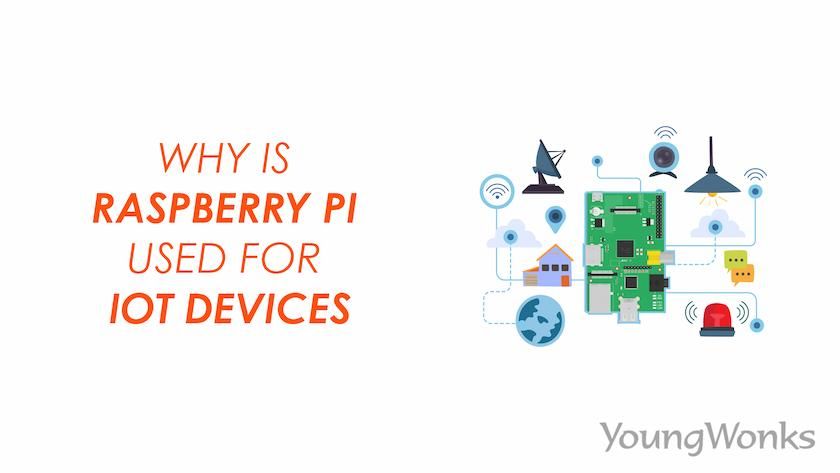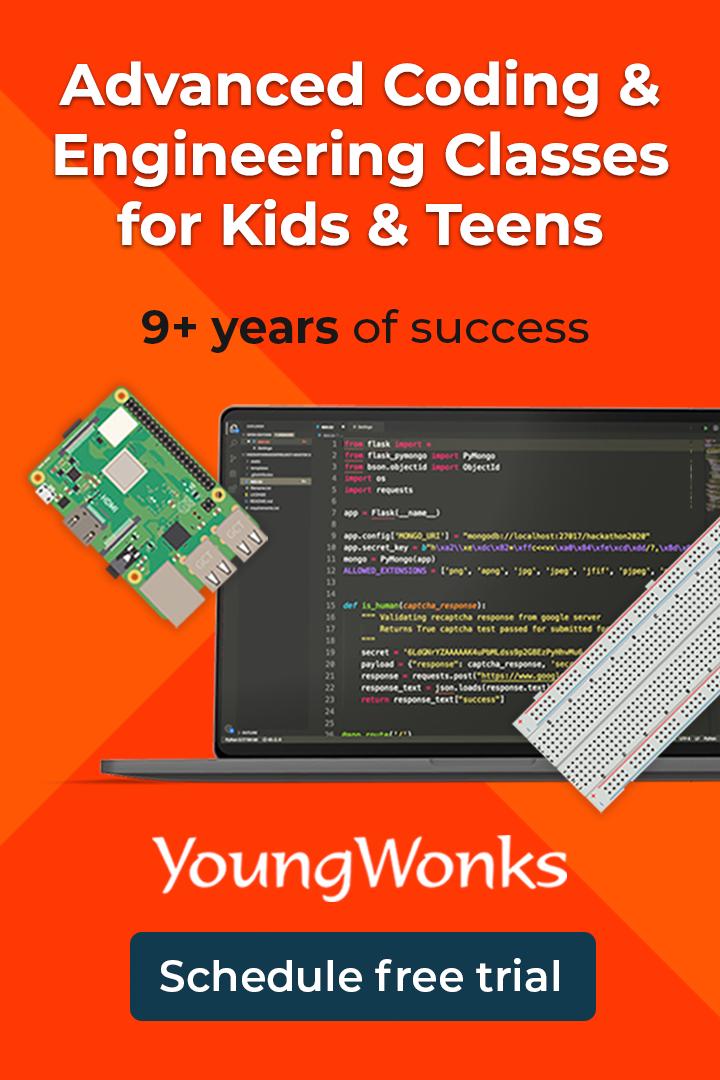Jun 26, 2024 By Team YoungWonks *
What is Raspberry Pi?
The Raspberry Pi (RPi) is a single-board computer (SBC) developed by the Raspberry Pi Foundation to promote learning in computer science and electronics.
- Runs on Linux-based operating systems like Raspbian OS, Ubuntu, and Debian.
- Supports multiple programming languages including Python, Java, and C++.
- Compact, low-power, and highly versatile for IoT projects.
For more in-depth guides, updates, and official resources, be sure to visit the Official Raspberry Pi Foundation website.
Why Raspberry Pi is Ideal and Preferred for IoT Devices
Raspberry Pi has become a top choice for IoT (Internet of Things) projects due to its compact size, low power consumption, affordability, and versatility. It is widely used in embedded systems, smart devices, and DIY electronics thanks to its robust performance and accessible ecosystem.
Small size, Energy-Efficient & Cost-Effective :
- Its small size and minimal power usage make it ideal for IoT devices that need to operate in compact spaces or run continuously.
- Compared to traditional computers, Raspberry Pi is extremely cost-effective and low cost, making it perfect for DIY projects, home automation, and sensor-based applications.
- It consumes less energy, making it suitable for real-time monitoring and 24/7 operations.
Strong Computing & Data Processing Capabilities:
- Powered by a Quad-Core ARM CPU and a Broadcom chipset, Raspberry Pi provides sufficient processing power for handling sensor data, automation tasks, and networked systems.
- With SD card storage, it allows for memory expansion in more complex Raspberry Pi projects.
- Example: A weather station built on Raspberry Pi can collect sensor data and analyze weather patterns in real-time.
Wide Connectivity Options for IoT Applications:
Raspberry Pi supports various connectivity options essential for IoT applications:
- Wi-Fi & Ethernet : For reliable internet access in smart home and remote monitoring systems.
- Bluetooth : Enables communication with smartphones, credit card readers, and smart home devices.
- GPIO Pins (General Purpose Input/Output) : Allow seamless connection to sensors, actuators, and controllers for customized interactions.
Open-Source, Expandable & Beginner-Friendly:
- Compatible with multiple operating systems including Linux, Debian, Ubuntu, Windows IoT Core, and even Android.
- It works smoothly with other devices like Raspberry Pi 3, Arduino, and various smart devices, enhancing its flexibility for IoT development.
- Supported by a vast open-source community, Raspberry Pi offers extensive DIY tutorials, documentation, and learning resources.
- Ideal for beginners exploring robotics, IoT, and embedded systems, with access to Raspberry Pi Official Tutorials and countless community-led projects.
How Raspberry Pi Enhances IoT Projects?
Smart Home Automation & DIY IoT Projects
The Raspberry Pi is a popular choice for smart home solutions due to its versatility and open-source nature. You can use it for:
- Home Automation : Controlling lights, thermostats, and security cameras.
- Robotics : Powering robots with actuators, motors, and microcontrollers.
- Weather Monitoring : Setting up a weather station to measure temperature and humidity.
Support for Multiple Programming Languages
Since IoT projects involve data collection and automation, programming is crucial. The Raspberry Pi supports:
- Python : The most common language for IoT programming.
- Java : Used in IoT applications and Android development.
- Scratch : Beginner-friendly language for simple IoT projects.
Compatibility with Sensors & Peripherals
The Raspberry Pi can integrate with:
- Arduino & Microcontrollers : Expanding functionality for IoT devices.
- USB, HDMI, and Peripherals : Connecting smartphones, cameras, and keyboards.
- Raspberry Pi Boards : Various models like Raspberry Pi 3 and Raspberry Pi 4 offer improved processing power and network connectivity.
Getting Started with Raspberry Pi for IoT
Ready to build your first IoT project? Here’s what you need:
List of Components:
- Raspberry Pi Board (Raspberry Pi 3 or Raspberry Pi 4)
- Micro SD Card (16GB or more) with Raspbian OS or Ubuntu pre-installed
- Power Supply (5V 3A USB-C recommended)
- Wi-Fi dongle or built-in module, Bluetooth, or Ethernet cable for network connectivity
- GPIO-compatible Sensors and Actuators (DHT11, PIR sensor, Relay module, etc.)
- Breadboard and Jumper Wires
- USB Keyboard and Mouse
- HDMI Cable and monitor
- Internet-enabled device for remote access or SSH configuration
Step-by-Step Setup:
- Install Raspbian OS on your micro SD card using Raspberry Pi Imager.
- Insert the SD card into the Raspberry Pi and connect HDMI, USB peripherals, and power supply.
- Boot up your Pi and connect to Wi-Fi or Ethernet.
- Open the terminal and update the packages: sudo apt update && sudo apt upgrade
- Enable SSH and GPIO Interface via raspi-config tool.
- Install Python and necessary libraries: sudo apt install python3-pip and pip3 install RPi.GPIO Adafruit_DHT
- Connect your sensors or actuators to GPIO pins using a breadboard.
- Begin your first script in Python to read sensor data or control an actuator.
- Monitor live data and visualize output using tools like Node-RED, Grafana, or upload to cloud platforms like ThingSpeak or Blynk.
- Refer to Official Getting Started Guide for more help.Top 10 Raspberry Pi IoT Projects You Can Build Today
Top 10 Raspberry Pi IoT Projects You Can Build Today
Explore these beginner-to-advanced Raspberry Pi IoT projects with helpful tutorials and resources:
- Smart Home Automation System : Control lights, thermostats, and appliances remotely via a web interface.
- Weather Station : Use sensors to monitor temperature, humidity, and pressure and display data in real-time.
- Face Recognition Door Lock : Enhance home security using facial recognition and sensor data. Face Recognition Smart Door Lock with Raspberry Pi
- Smart Mirror : Display weather, time, and calendar data using a monitor behind a two-way mirror.
- IoT Agriculture Monitoring System : Track soil moisture, sunlight, and automate irrigation.
- Bluetooth-Enabled Robot Car : Build a DIY car controlled via smartphones using Bluetooth and Python.
- Network Monitoring Tool : Analyze network usage and speed with continuous data logging. Monitor Network Performance with Raspberry Pi
- Android-Powered Media Center : Convert your Pi into a media hub powered by Android or Kodi.
- Smart Plant Watering System : Automate plant watering with moisture sensors and a water pump.
- IoT-Based Gas Leakage Detector : Detect harmful gases and send alerts to smartphones or dashboards.
These projects not only enhance your skills in IoT, programming, and hardware integration but also serve practical purposes in daily life and professional environments.Popular IoT Projects Using Raspberry PiHere are some Raspberry Pi projects that showcase the potential of this device in the IoT ecosystem:
Final Thoughts
The Raspberry Pi Foundation has created a powerful yet affordable solution for IoT applications. Whether you're working on home automation, data analysis, weather stations, or robotics, the Raspberry Pi provides high functionality, network connectivity, and versatility.
*Contributors: Written by Prarabdh Joshi; Edited by Disha N; Lead image by Shivendra Singh

